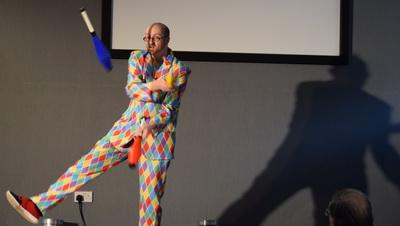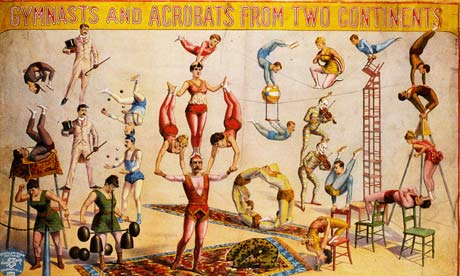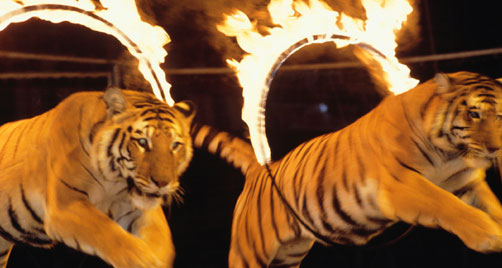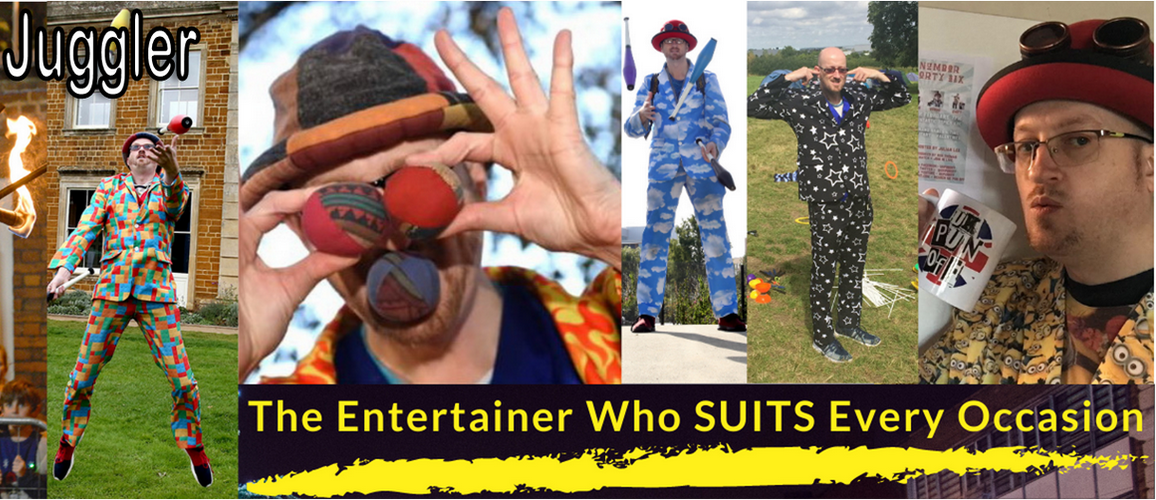| Steve has a History of the Circus 30min Show that he tours around Schools and Kid’s Events (also suitable for Women’s Institute and Ladies Groups)! If you have a Circus Project or would like to learn all about the Circus, contact Steve! |
The first Circus was created over 2000 years ago. Circus is a Latin word, which comes from the Greek ‘Kirkos’, meaning a circle or ring. Circus, in Roman times referred to a circular or oval area surrounded by tiered rows of seats.
The Circus Maximus was the first Circus established in Rome. This was a massive open air arena with an oval ring. There was enough space for 250,000 spectators so it was enormous! The arena was used for chariot races, battle re-enactments, horse shows and other entertainment. Acrobats and jugglers entertained the audience between the main events, while trained exotic animals were also on display.
The End of the Circus? When the Roman Empire fell, Circuses disappeared. Showmen and small groups of entertainers “wandering minstrels” wandered from town to town throughout Europe, keeping the Circus alive throughout the 14th and 15th Centuries. This worked well until around the 16th Century, around the time of Queen Elizabeth 1st when these Wandering Minstrels and travelling communities became considered a menace to society, and entertainers were requested to perform in set locations rather than be allowed to wander freely. The main place of entertainment during these years would have been Country Fairs.
 |
Steve has a History of the Circus 30min Show that he tours around Schools and Kid’s Events. If you have a Circus Project or would like to learn all about the Circus, then contact Steve! |
The Circus Returns! In London, on 9 January 1768, the Circus as an exhibition of acrobatics, horses and other Circus Performances returned. Philip Astley was the man in charge, and he is considered to have established the first permanent travelling Circus. He also realised that instead of performing his equestrian (horse) acts in a linear fashion (galloping along beside a line of spectators), he could make a lot more money by making the horses gallop in a ring that was surrounded by tiered seats around the performance area. With further experimentation, this clever man worked out that the diameter of the Circus ring should be set at exactly 42ft which was the amount of space that horses required to circle round at a comfortable gallop! German and Italian tent makers, and later French manufacturers, were responsible for the new tent and seating systems that made many European travelling circuses almost as comfortable and efficient as any show in a permanent building.
The Ringmaster: Although today, the role of the ringmaster is to announce the acts and keep the show moving along at a good pace, the role of the ringmaster back in the 18th Century was to keep the horses running correctly round the ring and that’s why their costume is a traditional riding costume.
Building the Circus: the Circus became very popular in England. Large cities began building arenas to house the shows. The London Hippodrome was built to house a Circus, menagerie (to safely house the exotic and domestic animals)and theatre. Wild animals including lions and elephants were often shown in the ring.
 Growth of the Circus: In 1825, Joshuah Purdy Brown was the first person to use a large canvas tent for Circus performances. Circuses became popular in the USA, led by P.T.Barnum, who originally specialised in running sideshow and freakshow businesses.
Growth of the Circus: In 1825, Joshuah Purdy Brown was the first person to use a large canvas tent for Circus performances. Circuses became popular in the USA, led by P.T.Barnum, who originally specialised in running sideshow and freakshow businesses.
Moving the Circus: William Cameron Coup was the first Circus owner to introduce the Circus train, which transported shows from town to town. Many circuses today in America still use trains to get around. Coup also introduced the concept of a multi-ring Circus, where more than one act takes place at a time.
The Travelling Circus: Thomas Taplin Cooke brought his entire Circus company to America in 1836. When he returned to England,he brought the idea of the Circus Tent home with him. His daughter Maryann and her husband William Cole stayed behind. Their son WW Cole would become the first circus millionaire in America. Thomas Cooke’s son William ran Astley’s in London for many years. Thomas Cooke’s descendants influenced circus in America, Australia, England, Russia and Europe for the next 100 years.
Other Circus owners, from France and Italy, began touring across Europe, and the rest of the world. New acts including Chinese acrobatics, the diabolo and plate spinning were introduced as the popularity of the Circus continued to grow.

a Victorian Circus Poster
Marketing: With the increase in popularity for the Circus (especially in America), came an increase in publicity and marketing. In order to announce back in the 1800’s that there was a Circus coming to town, they couldn’t put up a Facebook event, and post a few YouTube clips! If a Circus was coming to your town, you would definitely know about it from the amount of people who arrived armed with posters, flyers and discount coupons to tell you all about it! There would almost certainly be a parade through your town with plenty of opportunity for photographs and drumming up all the publicity that would ensure a sold out tent for the week!
Clowning and Mime: The American Circus introduced us to more clowning and mime. If you were playing in big arena’s it could be difficult to be heard, so there was a surge in the use of physical comedy, as well as many more big acts with danger and strength.

Trapeze: Many acts are important to a modern day circus but the one that is synonymous with the word circus, of the human kind, is the flying trapeze. A man called Jules Leotard was the first to perform on the flying trapeze on November 12th, 1859, in the Cirque Napoleon in Paris. The original act consisted of the performer swinging on one trapeze bar then releasing it and “flying” to a second bar. A decade later, a second performer was added and the flying trapeze artist flew to the hands of the “catcher”. After each trick the flyer would have to drop into a net and climb back to the platform, retrieve the bar, then perform the next trick. This could be why a 3rd performer was soon added to the routine, as they could remain on the platform, catch the empty bar, and swing it over to the flyer who caught it and returned to the platform without having to drop to the net. Soon, there were trapeze artists being added to every Circus that visited towns, and the tricks got even more breathtaking and dangerous!
Circus University in Russia: The State University of Circus & Variety Arts was set up by the Russian Government in 1927 at the request of the man in charge who was called Lenin. It became known as the Moscow Circus School. The University mainly focussed on teaching gymnastics that could be used within the Circus. When the Moscow State Circus began touring in the 1950’s, it was an amazing success and changed how modern Circuses would progress.

Animals and the Circus: A variety of animals have always been used in the Circus from the very early days right up until now. Although the first animal acts were horses, it didn’t take long for elephants and the big cats (lions, tigers etc) to be trained and used in cages or let loose in the Circus Ring. In the 1960’s, people became much more aware of animal rights. Many people thought that it was no longer acceptable to use animals in the Circus. Some circuses had to close as a result of boycotts and demonstrations held against them. New laws have been put in place to ensure the well-being of all Circus animals and harsh penalties for those who mistreat them.
The New Circuses: Because of the animal rights issues, some Circuses decided to move away from animal performances completely. This move led to some of the most amazing and popular animal-free Circus shows, of which the most famous in modern times is the Cirque Du Soleil (founded in 1984 from Canada) who do many of their wonderful and technically skilled performances to music. They currently make profits of around £534 million pounds every year, so that proves that the Circus is still very popular and able to generate an income for those prepared to develop good shows and live a life on the road!
 Steve has a History of the Circus 30min Show that he tours around Schools and Kid’s Events. If you have a Circus Project or would like to learn all about the Circus, then find out more by visiting
Steve has a History of the Circus 30min Show that he tours around Schools and Kid’s Events. If you have a Circus Project or would like to learn all about the Circus, then find out more by visiting
Steve’s History of the Circus page!

